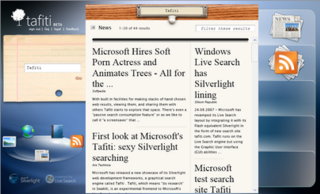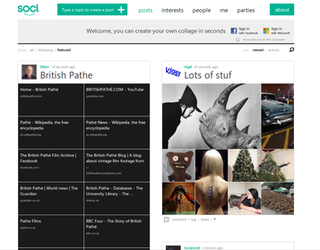
MSN is an American web portal and related collection of Internet services and apps for Windows and mobile devices, provided by Microsoft and launched on August 24, 1995, alongside the release of Windows 95.
Microsoft Research (MSR) is the research subsidiary of Microsoft. It was created in 1991 by Richard Rashid, Bill Gates and Nathan Myhrvold with the intent to advance state-of-the-art computing and solve difficult world problems through technological innovation in collaboration with academic, government, and industry researchers. The Microsoft Research team has more than 1,000 computer scientists, physicists, engineers, and mathematicians, including Turing Award winners, Fields Medal winners, MacArthur Fellows, and Dijkstra Prize winners.

Gary William Flake was most recently the CTO of Search at Salesforce.com, which bought and shuttered Clipboard, Inc., of which he was the founder and CEO.

Bing Maps is a web mapping service provided as a part of Microsoft's Bing suite of search engines and powered by the Bing Maps Platform framework which also support Bing Maps for Enterprise APIs and Azure Maps APIs. Since 2020, the map data is provided by TomTom, OpenStreetMap and others.

Microsoft Bing, commonly referred to as Bing, is a search engine owned and operated by Microsoft. The service traces its roots back to Microsoft's earlier search engines, including MSN Search, Windows Live Search, and Live Search. Bing offers a broad spectrum of search services, encompassing web, video, image, and map search products, all developed using ASP.NET.
Windows Live Toolbar was a browser extension toolbar for Internet Explorer. It superseded MSN Search Toolbar. Windows Live Toolbar provided a simple search interface that starts to list results as the user types in a search query and uses Bing as its search engine. The toolbar also allows users to synchronize their Internet Explorer favorites across multiple computers and provides an interface to Windows Live and MSN services.
Microsoft engineering groups are the operating divisions of Microsoft. Starting in April 2002, Microsoft organised itself into seven groups, each an independent financial entity. In September 2005, Microsoft announced a reorganization of its then seven groups into three. In July 2013, Microsoft announced another reorganization into five engineering groups and six corporate affairs groups. A year later, in June 2015, Microsoft reformed into three engineering groups. In September 2016, a new group was created to focus on artificial intelligence and research. On March 29, 2018, a new structure merged all of these into three.
Bing Shopping is a products search and discovery service that helps save time by bringing products from multiple sellers together on a single website. It uses Bing to show product results–including photos and product details. Products can be filtered and prices compared. Purchases are completed on the seller's website.

Microsoft Academic Search was a research project and academic search engine retired in 2012. It relaunched in 2016 as Microsoft Academic, which in turn was shut down in 2022. The content of the latter was allegedly incorporated into The Lens.

Tafiti was an animated search engine launched by Microsoft to showcase the Silverlight animation and video player.
Powerset was an American company based in San Francisco, California, that, in 2006, was developing a natural language search engine for the Internet. On July 1, 2008, Powerset was acquired by Microsoft for an estimated $100 million.
Heung-Yeung "Harry" Shum is a Chinese computer scientist. He was a doctoral student of Raj Reddy. He was the Executive Vice President of Artificial Intelligence & Research at Microsoft. He is known for his research on computer vision and computer graphics, and for the development of the search engine Bing.

Microsoft Translator is a multilingual machine translation cloud service provided by Microsoft. Microsoft Translator is a part of Microsoft Cognitive Services and integrated across multiple consumer, developer, and enterprise products, including Bing, Microsoft Office, SharePoint, Microsoft Edge, Microsoft Lync, Yammer, Skype Translator, Visual Studio, and Microsoft Translator apps for Windows, Windows Phone, iPhone and Apple Watch, and Android phone and Android Wear.
Microsoft adCenter Labs, is an applied research group at Microsoft that supports Microsoft adCenter. Microsoft adCenter, is the division of the Microsoft Network (MSN) responsible for MSN's advertising services.

Lu Qi is a Chinese-American software executive and engineer who is the head of MiraclePlus, a startup incubator in China. Previously, Lu was the head of Y Combinator's China until it was shut down. He was formerly the chief operating officer of Baidu until he stepped down in May, 2018. He has served as the executive vice president of Microsoft, leading development of Bing, Skype, and Microsoft Office, and software engineer and manager for Yahoo!'s search technology division.
Seadragon Software was a team within the Microsoft Live Labs. Its product, Seadragon, is a web optimized visualization technology that allows graphics and photos to be smoothly browsed, regardless of their size. Seadragon is the technology powering Microsoft's Silverlight, Pivot, Photosynth and the standalone cross-platform Seadragon application for iPhone and iPad.

Kristin Estella Lauter is an American mathematician and cryptographer whose research interest is broadly in application of number theory and algebraic geometry in cryptography. She is particularly known for her work in the area of elliptic curve cryptography. She was a researcher at Microsoft Research in Redmond, Washington, from 1999–2021 and the head of the Cryptography Group from 2008–2021; her group developed Microsoft SEAL. In April 2021, Lauter joined Facebook AI Research (FAIR) as the West Coast Head of Research Science. She became the President-Elect of the Association for Women in Mathematics in February 2014 and served as President February 1, 2015 - January 31, 2017.
Microsoft's Future Social Experiences (FUSE) Labs was started by Ray Ozzie and is run by Lili Cheng. The group focuses on real-time and media rich experiences and is located in Bellevue, WA. It used to have offices in Cambridge, Massachusetts, and Cambridge, UK. A similar, earlier initiative was Microsoft Live Labs, a collaboration between Microsoft Research and MSN which ended in 2010.

So.cl was a social networking service and social search engine operated by Microsoft FUSE Labs. They announced on March 7, 2017 that it would be closing down So.cl on March 15, 2017.
Microsoft mobile services are a set of proprietary mobile services created specifically for mobile devices, they are typically offered through mobile applications and mobile browser for Windows Phone platforms, BREW, and Java. Microsoft's mobile services are typically connected with a Microsoft account and often come preinstalled on Microsoft's own mobile operating systems while they are offered via various means for other platforms. Microsoft started to develop for mobile computing platforms with the launch of Windows CE in 1996 and later added Microsoft's Pocket Office suite to their Handheld PC line of PDAs in April 2000. From December 2014 to June 2015, Microsoft made a number of corporate acquisitions, buying several of the top applications listed in Google Play and the App Store including Acompli, Sunrise Calendar, Datazen, Wunderlist, Echo Notification Lockscreen, and MileIQ.










